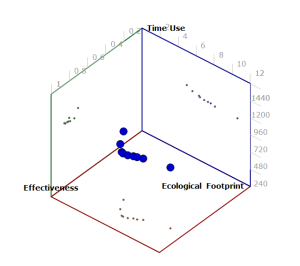I was speaking with a colleague recently about what I’d like to do relating to housing, and I’ve repeated much of it here:
I’d love to build DHW system that is solar+on-demand. This would involve conventional solar thermal collectors running at between 60C and 70C, an insulated wax tank within the building envelope, and greywater heat recovery. One heat exchanger dumps heat into the wax when the sun is shining, storing heat in the phase change at something above 55C, and another draws heat out on demand at something above 35C. My math says about 3 T of wax is sufficient for an off-grid home filled with teenage girls to get through November.
I’d love to build a solar concentrator to pipe light into conventional buildings to provide hybrid solar. 10 Suns, or even 100 suns would be really interesting to me. The hybrid part would include small LEDs connected to solar panels and lithium batteries that would be entirely self-contained, so when the sun is shining in the room, the batteries are charging. Each light would be set to have a different background light level as a trigger to come on. As the light intensity dims, individual lights come on automatically, either as ambient light or task lighting. No penetrations in the building envelope, and a continuous gradation of lighting. Maybe they would share batteries in clusters…?
I’d love to find out how to do cooking off-grid. 10,000 suns can melt Bismuth (with a similar volumetric heat of fusion to water), at 271C. While that’s hot enough to use for cooking, I just can’t visualize how to store that safely, or what I would use as my heat exchange fluid, or how I would draw the heat out when I wanted to cook, or…
I’d love to build a system to store winter using ice as a phase change material. 17T stored in a straw bale vault replaces a refrigerator. 43T with a air-to-air heat pump provides all heating, cooling, refrigeration, and dehumidification (wanna keep you house at 14 C all summer?) for a well built house. The trick is to build a structure that is sufficiently flexible to avoid rupturing when the ice expands. I’ve got that…
I’d love to build a house in Ontario that doesn’t need a heating system. Build the walls and floors out of the soil you dig out of the basement, and have a thermal mass of hundreds of tonnes, and wrap in strawbale. It would be massive and passive (and I guess, glassive, since the south wall would be glazing). With the rest of those ideas, it would be entirely off grid, (except for cooking for now).
I’d love to use a DCFC to generate CHP using wood or farm waste as a feed stock. Hell, I’d love to be a vendor if such a product became available anytime soon. I heat with 6 Cord of wood per year, and spend about $2000/year on electricity. I’d love to burn 8 Cord of wood a year, and get all of my electricity for sweat alone.
My Sustainability design philosophy would be:
- use what you get for free (to be frugal)
- keep the energy in the form closest to the free source (to be efficient)
- understand the shadow that your system casts on the ecosystem (to be moral)
- resilience should not be abandoned for efficiency (to be adaptable)
